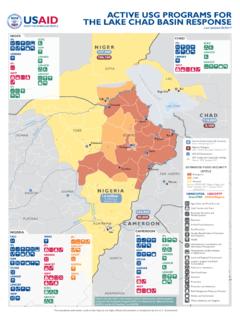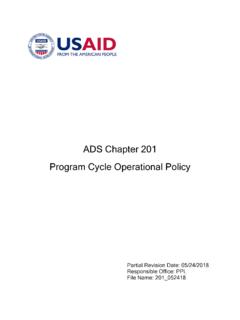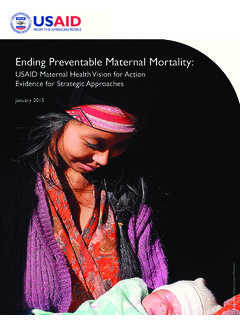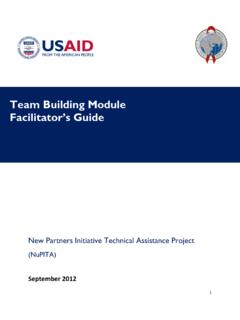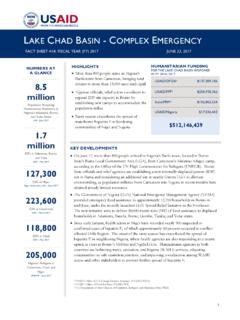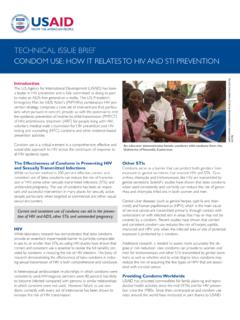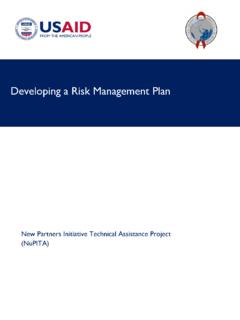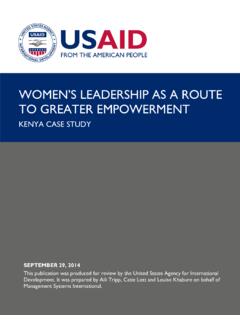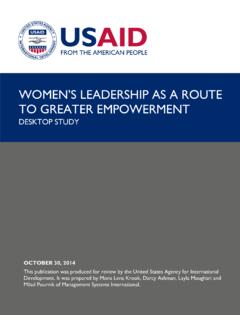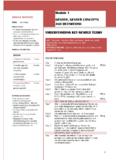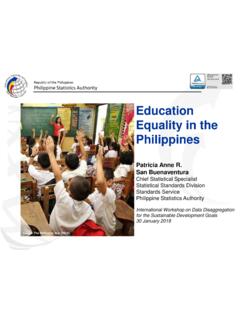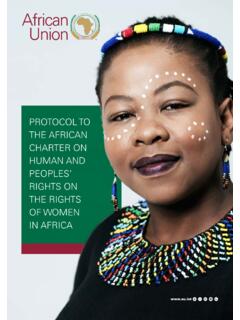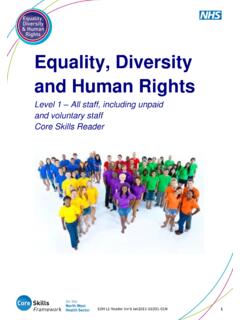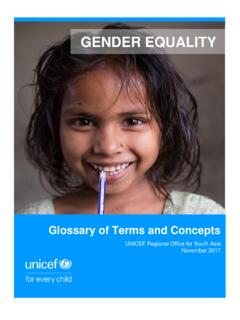Transcription of ADDENDUM TO THE 2012 GENDER ASSESSMENT
1 ADDENDUM TO THE 2012 GENDER ASSESSMENT May 2015 1 To ensure that USAID/Mali s current Country Development Cooperation Strategy (CDCS) process is well informed and inclusive of GENDER related issues, the Mission is submitting an ADDENDUM to the 2012 GENDER ASSESSMENT to highlight gaps, opportunities and priorities that will increase the impact, relevancy and efficiency of programming. The following ADDENDUM addresses changes in the operating context from the USAID/Mali 2012 ASSESSMENT and incorporates new analyses, consultations and reports to inform decision-making. In addition, this ADDENDUM speaks to the reinvigoration of USAID/Mali s CDCS process which proposes a cross-sectoral approach to the CDCS Results Framework process. This ADDENDUM is not a stand-alone document; rather, it updates issues and recommendations from the 2012 GENDER ASSESSMENT and discusses how USAID s strategy in the country context is well equipped to incorporate and address GENDER issues over the life of the strategy.
2 Background In 2012, USAID/Mali conducted a GENDER ASSESSMENT as part of its CDCS process. Subsequent to the completion of the GENDER ASSESSMENT and prior to completing the CDCS, Mali was victim to two simultaneous complex crises a Northern rebellion and a coup/counter coup attempt both events left lasting impacts on the development outcomes across the country and reoriented USAID s strategy in Mali. In a broader sense, Mali was left in a state of paralysis, with unprecedented levels of violence, government failure and a fractured society. As the country has worked to overcome these crises, USAID has adjusted its strategy appropriately, taking into account the underlying causes of the conflict and the resulting impacts on Malian ways of life. Importantly, USAID s strategy incorporates efforts to strengthen resilience, thereby increasing adaptive capacities of vulnerable communities and households to climate shocks and stresses, improving conflict mitigation capabilities, diversifying livelihoods and strengthening human capital.
3 Under this pretext, USAID s strategy addresses various aspects of GENDER , including lesbian, gay, bisexual and transgender (LGBT) issues. In conjunction with USAID/Mali s traditional development interventions in health, agriculture, economic growth and democracy and governance is an understanding that mandating a GENDER -sensitive approach to programming will improve the likelihood of success in each sector, resulting in a better use of resources and more sustainable and effective development outcomes. Complicating development efforts while providing learning opportunities, is the coordinated fight against the spread of Ebola Virus Disease (EVD) in West Africa. As the Mission works to mitigate the negative effects a continued and sustained outbreak would have on Mali s health systems, its workers, and the use of essential reproductive, maternal, newborn, and child health services, USAID recognizes the unique opportunity to take advantage of structures, relationships and communication tools that have been introduced throughout the isolated EVD clusters in Mali.
4 In recognition that GENDER roles can impact the detection, spread, containment and prevention of EVD because women, men, girls and boys can experience crisis differently, USAID/Mali is targeting decision-makers, medical personnel, aid workers and security staff responding to the EVD crisis. Sectoral considerations for EVD response are included below. Today, Mali is moving in a direction that will improve the lives of its citizens - especially women and youth. The conflict destroyed normal life for hundreds-of-thousands of Malians from both sexes, however, it also drew attention to the status of women and girls across Mali and enables USAID to 2 capitalize on a renewed sense of vigor as citizens demand rights from the State and donor countries re-engage the Government to pursue development outcomes. Under these pretexts, USAID/Mali revisited its GENDER ASSESSMENT to create an ADDENDUM responding to unique development challenges resulting from the situational changes in the operating environment confronting issues such as internally displaced persons and the persistent security risk in the North.
5 In accounting for these new realities, USAID/Mali has adjusted programs to incorporate a transition initiative in its CDCS as Mali moves towards a more stable status quo and has adapted longer-term development programs to incorporate resilient, sustainable development activities. This ADDENDUM focuses on those issues which were most affected by the conflict and which are within USAID s manageable interest to address through available resources and programming. Current GENDER Situation in Mali Since the 2012 analysis, there has been relatively little change in the general situation, where Mali remains near the bottom of most indices: Human Development Index (HDI): Mali dropped one spot, from 175th out of 187 countries in 2012 to 176th out of 189 countries in The HDI takes into account income, life expectancy at birth, the rate of adult literacy and school enrollment, among other development indicators.
6 GENDER Inequality Index (GII): Mali dropped five spots, from 143rd out of 146 countries in 2012 to 148th out of 152 The GII draws attention to major deficits in human development due to GENDER inequality, such as reproductive health, empowerment and economic activity. GENDER Related Development Index (GDI): Mali ranks 143rd out of 148 The GDI measures GENDER gap in human development in health (male & female life expectancy at birth), education (male & female expected and mean years of schooling), command over economic resources (male & female estimated earned income). This ranking takes equally into consideration GENDER gaps hurting females and males. In addition, there have been multiple cases of kidnapping and rape of women following the April 2012 seizure of control by separatists and jihadists in the North. These rankings are indicative of the fact that the 2012 conflict in Mali held hostage many efforts to improve these rankings through Government of Mali intervention and targeted development assistance.
7 While the traditional values and practices that impact GENDER equality continue, the conflict and consequences of lawlessness have created additional gaps and needs for the people of Mali. One of the most blatant examples of this is GENDER Based Violence (GBV). As with conflicts the world over, incidences of GBV and the means through which it is committed were exacerbated by the conflict and present new challenges to GENDER equality and programming in Mali. As was concluded in the 2012 GENDER analysis, key GENDER disparities include unequal access to financial resources, very limited capacity for women to engage in decision-making in families, low level of female leadership within state structures, and prominent representation of men in elective institutions. Conflict inevitably impacts these 1 2 3 3 aspects of GENDER and further affects social constructs, reducing women s access to, control over, and benefit from resources, wealth and opportunities.
8 These reasons, among others, will continue contributing to negative scores in GENDER -parity indicators. Recently, the Government of Mali (GOM) has wavered in its efforts to promote and defend female empowerment and GENDER equality . In July 2014, the Cabinet of Ministers adopted a law promoting women s participation in political arenas. Despite this encouraging sign, the law was not enacted as a result of a February 2015 National Assembly vote, resulting in a defeat for this important step to deconstructing one of the major barriers to female empowerment and GENDER equality . While the 2012 report discusses the GOM s commitment to female empowerment and GENDER equality , including among sex workers and the Lesbian, Bisexual, Gay, and Transgender (LGBT) populations, it is no longer apparent that such initiatives enjoy wide support across the Malian government. Continuing the fight for reform and serving as a catalyst and coordinator for GENDER -responsive actions to other ministries and implementing programs focused on women s strategic interests, the Ministry for the Promotion of Women, Children and the Family (le Ministre de la Promotion de la Femme, de l Enfant et de la Famille MPFEF) has remained the leader on GENDER -related issues in Mali.
9 As noted in the Beijing Report + 20, MPFEF has had successes in advocating for GENDER inclusive policies and laws in Mali. Despite documented improvements in this area, there remain several obstacles to achieving equality between sexes. A major obstacle for women continues to be the lack of a quota law for women s participation in political bodies - reinforced by the aforementioned National Assembly vote. Since 2007, women have not made up more than of candidates for any one election. The MPFEF continues to hold as a major goal the adoption of a quota law to encourage and increase participation of women in political processes in Mali, in addition to the 2013-2017 National HIV/AIDS Strategy includes the protection of the human rights of key populations at risk for HIV, including female sex workers and LGBT populations as a key goal. Overall, the GOM appears to have lost ground in its commitment to fostering GENDER equality .
10 USAID/Mali continues to work to promote women s participation in the peace and security, political and civil society processes. The ongoing peace process presents opportunities to engage women, youth and other disenfranchised groups in the process. Democratic Governance USAID/Mali s CDCS recognizes that all of our traditional program areas - health, education, and economic growth require improved governance and resilience to succeed. And, given Mali s ranking near the bottom of the worldwide GENDER Inequality Index, a transparent, accountable, and responsive government is essential to ensuring that women have equal access to justice, health care, education, and economic resources as well as empowerment over their reproductive health and livelihoods. Therefore, activities that correct inequities and advance the rights of women will be addressed across sectors and in each of the awards. The Mission strategy aims to instill good governance in all program areas, particularly as it impacts women.
